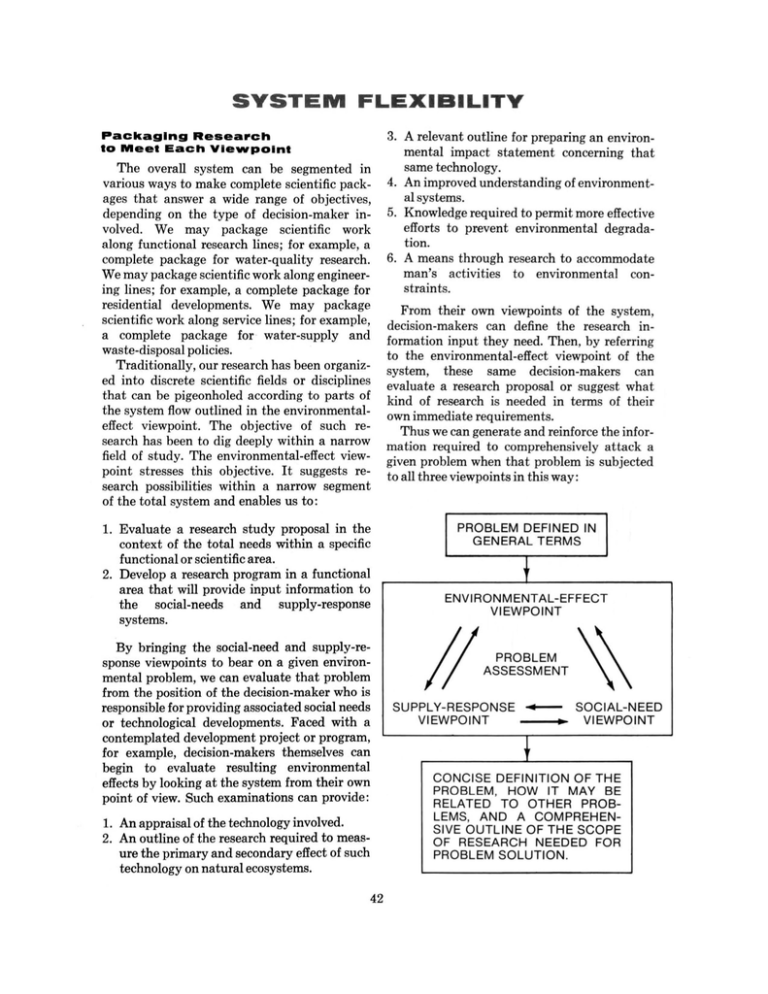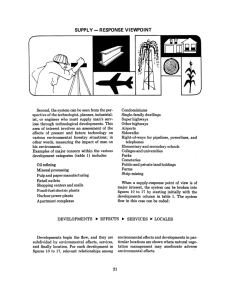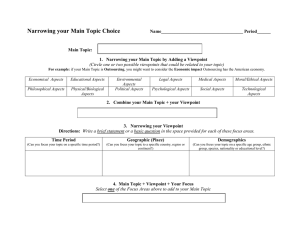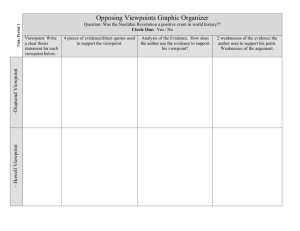Document 11878240
advertisement

3. A relevant outline for preparing an environmental impact statement concerning that same technology. 4. An improved understanding of environmental systems. 5. Knowledge required to permit more effective efforts to prevent environmental degradation. 6. A means through research to accommodate man's activities to environmental constraints. Packaging Research to Meet Each Viewpoint , The overall system can be segmented in various ways to make complete scientific packages that answer a wide range of objectives, depending on the type of decision-maker involved. We may package scientific work along functional research lines; for example, a complete package for water-quality research. We may package scientificwork along engineering lines; for example, a complete package for residential developments. We may package From their own viewpoints of the system, scientific work along service lines; for example, decision-makers can define the research ina complete package for water-supply and formation input they need. Then, by referring waste-disposal policies. to the environmental-effect viewpoint of the Traditionally, our research has been organiz- system, these same decision-makers can ed into discrete scientific fields or disciplines evaluate a research proposal or suggest what that can be pigeonholed according to parts of kind of research is needed in terms of their the system flow outlined in the environmental- own immediate requirements. effect viewpoint. The objective of such reThus we can generate and reinforce the inforsearch has been to dig deeply within a narrow mation required to comprehensively attack a field of study. The environmental-effect view- given problem when that problem is subjected point stresses this objective. I t suggests re- to all three viewpoints in this way: search possibilities within a narrow segment of the total system and enables us to: I 1. Evaluate a research study proposal in the context of the total needs within a specific functional or scientificarea. 2. Develop a research program in a functional area that will provide input information to the social-needs and supply-response systems. By bringing the social-need and supply-response viewpoints to bear on a given environmental problem, we can evaluate that problem from the position of the decision-maker who is responsible for providing associated social needs or technological developments. Faced with a contemplated development project or program, for example, decision-makers themselves can begin to evaluate resulting environmental effects by looking a t the system from their own point of view. Such examinations can provide: 1. An appraisal of the technology involved. 2. An outline of the research required to measure the primary and secondary effect of such technology on natural ecosystems. PROBLEM DEFINED IN GENERAL TERMS I ENVIRONMENTAL-EFFECT VIEWPOINT // I ASSESSMENT PROBLEM SUPPLY-RESPONSE VIEWPOINT \\ - SOCIAL-NEED VIEWPOINT CONCISE DEFINITION OF THE PROBLEM, HOW IT MAY BE RELATED TO OTHER PROBLEMS, AND A COMPREHENSIVE OUTLINE OF THE SCOPE OF RESEARCH NEEDED FOR PROBLEM SOLUTION. However, in the final analysis of any given problem, the effects of the social and supply innovations will be determined not by the extent to which man can manipulate the external world but by the limitations of the ecosystem (or environmental-effect viewpoint). The ecosystem constraints set the sideboards for the ultimate solution to any given problem. Only in this way will the research approach provide answers that insure the proper functioning of natural ecosystem required for man's ultimate survival i n and around Megalopolis. Who, What, Where, When, Why, and How3 The six questions (who? what? where? when? why? and how?) about research are often difficult to answer explicitly. This system, however packaged, should make answering them easier. The environmental-effects and services components taken together broadly answer the question what. The development and locale segments taken together broaclly answer where. Answers to these two questions go a long way toward determing how to conduct the research, although much of the how sometimes must (and should) be left to the researcher's ingenuity. Use of the system to indicate relevant combinations shows why the work is important. We already know the scientist is going to do the work, and the research administrator says when. A DIAGRAM OF THE ENTIRE SVSTEM PINCHOT INSTITUTE * v * OF ENVIRONMENTAL FORESTRY RESEARCH -..RONMENTAL AIR QUALITY *WATER EF~LI m- IS THE SOCIAL WELL BEING OF A MAN I N MEGALOPOLIS BEING ENHANCE0 WITHOUT DESTROYING NATURAL ENVIRONMENTS REWIRED FOR HIS ENJOYMENT AND SURVIVAL r ECOLOGICAL SOLUTIONS lANGE OR MAINTAIN SPECIES C~MWSITION OF VEGETATION y *ALTER OR PRESERVE DWSITY OF VEGETATION *REARRANGE OR HOLD CONSTANT SPACIAL PATT ERNS OF VEGETATION *IMPROVE OR MAINTAIN PRODUCTIVITY--.AREA HOW THE SYSTEM WORKS A n Environmental-Effect Approach Use of the packages will be illustrated by example, and in this example our primary package will be formulated from the environmentaleffect viewpoint. We begin by assuming that a specific research proposal is made to a research administrator, and we trace the administrator's evaluation of the proposal with reference to the complete catalogue of studies in the general area of interest for a specific environmental effect. (The example is kept very simple here simply to illustrate the procedure.) A scientist proposes studying vegetation manipulation in housing developments in areas that the hzs research can be used where residents can enjoy certain songbirds and wild animals in suburbia. (Songbirds, incidentally, are also an extremely important factor in nutural ecosystems related to man" health and wellbeing.) Wildlife habitat (flora-fauna) is the central issue here, so we go first to the environmentaleffect viewpoint figures, select figure 23 (flora and fauna), and code the research proposal as 6-10-4-2: Enuironmental Effect Service Development Locale (flora-fama) (recreation (residences) (suburban) activity) To place the research proposal in perspective, we chart alI other flora and fauna effects in figure 23 that are relevant to suburbia (locale 2). We examine the interconnected parts of figure 23 that are relevant to the environmental effect stipulated in the proposed study. Those parts of that system are: ENVIRONMENTAL EFFECTS The number in each circle follows the num- 1. It is in a high-priority package category. bering code for effects, services, developments, 2. It is part of a group of 17 relevant packages and locales found in table 1. An asterisk along or study areas-of which 14 are high-priority the bottom line of numbers indicates a highpackages. priority package. The original proposal in the 3. Seven suburban services are involved in the flow chart is indicated by a heavy line. All other total subsystem-services 2,4,5,6, 7,9, and possibilities are shown by light lines. 10 (table 1). By evaluating the research proposal in this 4. Five developments in suburbs are involved way, we begin to see how it relates to a complete in the total subsystem-developments 1, 4, research program for flora and fauna effects in a 5,6,and 7 (table 1). suburban setting. By inspection, conclusions For evaluation of a study proposal by a can be reached on several important points regarding how the study is related to overall research administrator-and depending upon the ability, qualifications, and experience of the Pinchot Institute objectives: scientist-one of several recommendations is likely: The proposal is accepted and funded. The proposal is expanded to include other services, such as 4,6, and 9 as well as 10. The proposal is included in a larger study designed to encompass all 17 relevant study areas. Recommendation 3 is tantamount to a program-development charge; the research ad&nistrator has made a program-development analysis from the flow chart and indicates what to include and where to do it. The first step in program evaluation is taken. Next, a senior scientist should make an analysis of the problems within the program to determine what information is already known and what needs further research. A Soclal-Need Approach Now consider a research problem from the social-need response viewpoint. For example, a research question from this perspective could be: In the course of legislating housing needs (service 4 ) for suburban areas (locale 2 ) , what environmental effects will we encounter that may be ameliorated or protected through policies and programs governing vegetation management? What form of environmental forestry research is needed to develop relevant information for developing policy to regulate housing? The package code a t this point has only two numbers, one for services and one for locales : Services Effects Developments (housing) Locales (suburban) The missing parts of the package must be supplied to develop a research program. I n figure 3, social need number 4 (housing) is selected and traced through the paths (or subsystem) where the two codes (4 and 2) exist. Those parts of that system are: SERVICE ENVIRONMENTAL EFFECTS DEVELOPMENT LOCALES The number in each circle follows the number system for services effects, developments, and locales found in table 1. An asterisk along the bottom line of numbers indicates a high-priority package. Therefore, by filling in the missing code numbers so that all the relations can be traced, development of the program proposal for housing in suburbia has begun. Now we can recognize what environmental factors are relevant in this context and what developments they are related to : 1. Research capability in all six environmental categories in this program must be developed. 2. Only three developmental-viewpoint situations are likely to be encountered: a. Residence (4) under three environmental effects areas. b. Transportation (5) under four environmental effects areas. c. Forestry (7) under six environmental effects areas. 3. About one-third of the indicated study areas are high priority. Thus, as in the previous example, the problem dimensions are defined and the relative complexity is determined-clear avenues to problem seIections and analysis. The research adrninistrator interested in addressing the enhanced problem package has a point of beginning for determining the expertise and funding needed. A Supply-Response Approach In a traditional sense, the importance one should attach to evduating a given problem in the above manner depends upon the responsibilities of the one making the appraisal. A suburban real-estate developer, using the previous example, has an outline on which to base an environmental impact statement, or on which to make an engineering evaluation of technical alternatives. However, the developer-using the supplyresponse viewpoint-may ask the research question somewhat differently: I n the course of building suburban resi- dences (locale 2, development 4), what effectswill such development have on nutural systems of the environment thut can be enhanced, protected, or avoided through manipulation of vegetative composition, density, patterns, or productivity? Here the package code is: Developments (residences) Effects 4 ? Services Lode8 (suburban) ? 2 The missing parts of the package can be supplied by referring to figure 12 (residences) and tracing through the paths (or subsystem) where the two codes (4 and 2) exist. Those parts of the system are: DEVELOPMENT EMVlRONMENTAL EFFECTS The number in each circle follows the number system for services, effects, developments and locales found in table 1. An asterisk along the bottom line of numbers indicates a high-priority package. We conclude from this flow that: Capabilities in all six environmental categories are required. under two environmental effects. b. Housing (4) under three environmental effects. c. Transportation (5) under one environmental effect. d. Recreational structures (6) under three environmental effects. e. Health and welfare (9) ,under four environmental effects. f. Recreational activity (10) under three environmental effects. Six social services are also interrelated with 3. Three-quartem of the indicated study areas residences : have high priority. a. Water supply and waste disposal (1) the suburban developer and the policy-maker understand their roles in the total research A research administrator, wing the previous picture. Decision-makers from all three viewpoints example of how the system works, has an outline to help him evaluate a research proposal or now have broader based views, and they should to develop a research program. The research be able t o communicate their needs and proadministrator also sees that the wildlife-habitat lems with one another much more quickly and research program described in the example surely. Thus the reinforcing feedback loop of inforabout an environmental-effect viewpoint could constitute work in 20 to 25 percent of the sub- mation mentioned earlier for all three viewurban planner's environmental problems that points becomes readily apparent in the total are amenable to vegetation management. Both system. Advanaage of Uslng A l l Three Vlewpolnts RESEARCH PLANS TO ENHANCE THE SVSTEM Recognized Weaknesses The Pinchot Institute recognizes a t least nine aspects of this first-generation system for exploratory research and problem evaluation that need improvement: 1. Components in table 1 need to be revised and expanded where necessary. 2. Problems suggested by individual packages and groups of packages need to be defined explicitly. 3. Where answers to parts of problems already exist, results should be published in concise, compact form for use by decision-makers. I n this same regard, a continuous literature review is required to update and publish supplements to the initial reports. 4. Dependent and independent variables in each problem, or associated problems, need to be clarified. 5. Parallel and interconnecting Links among and within the major components of the system need to be explored in preliminary pilot research studies. 6. Preliminary research studies are needed to adequately assess the need for concentrated research a t given points or interconnecting sections of the system. 7. With the exception of a somewhat gross attempt to set priorities, a weighting procedure needs to be developed within the total system for allocating limited research funds and manpower. 8. As the system becomes more complex, retrieval computer procedures will need to be developed that will allow a given management problem to be defined from d three viewpoints and to print out either the location within the Consortium where the expertise p i s t s to solve the problem or the references in the literature where the total or partial solution to the problem can be found. 9. As information about the total Pinchot In- stitute system becomes available, multidisciplinary teams need to model the research-allocation system for a variety of environmental problems. Such an approach should eventually provide an optimum combination of packages that could be f.unded according to an expected payoff matrix of results. MultIdIsclpllnary Team Approach Multidisciplinary research teams have been established within the Pinchot Institute's Consortium of universities and inhouse research units to attack the nine basic weaknesses mentioned above. With the capability to .utilize the expertise of many disciplines that exist throughout its nine leading institutions, the Institute's Consortium can create almost any type of multidisciplinary team that may be required to solve environmental forestry problems throughout Megalopolis. The Consortium has the physical plant capabilties to comprehensively and quickly engage in research to answer the ecological-oriented problems of metropolitan planners and developers. Starting with a given viewpoint, each team examines groups of research packages within variaus park of the total system. Examples of elements to be considered by teams using each viewpoint have been listed previously in the descriptions of those three viewpoints. When a team is satisfied that it has considered most of the important dependent and independent variables of interest, the framework for writing a problem analysis and for developing individual research studies becomes fairly straightforward.






